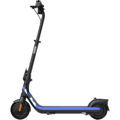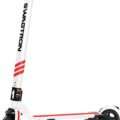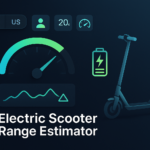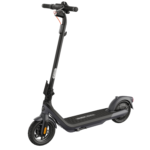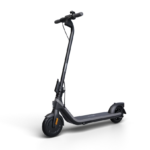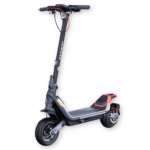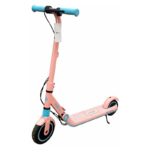- Home
- Scooters
- Electric Scooters
- Segway Ninebot MAX G30
Segway Ninebot MAX G30
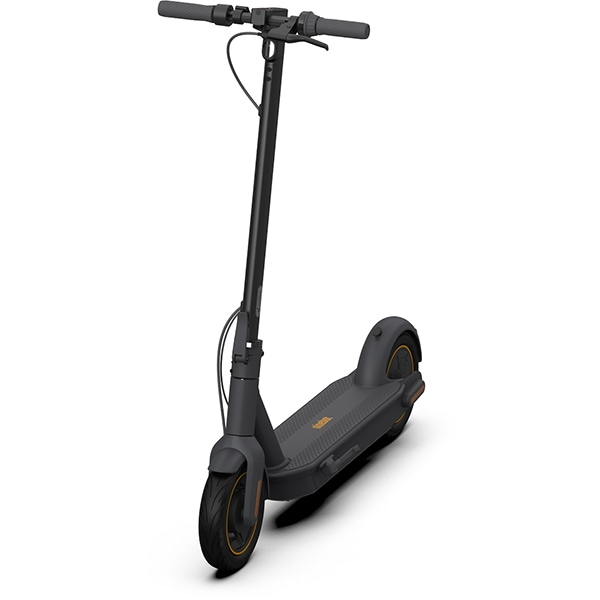


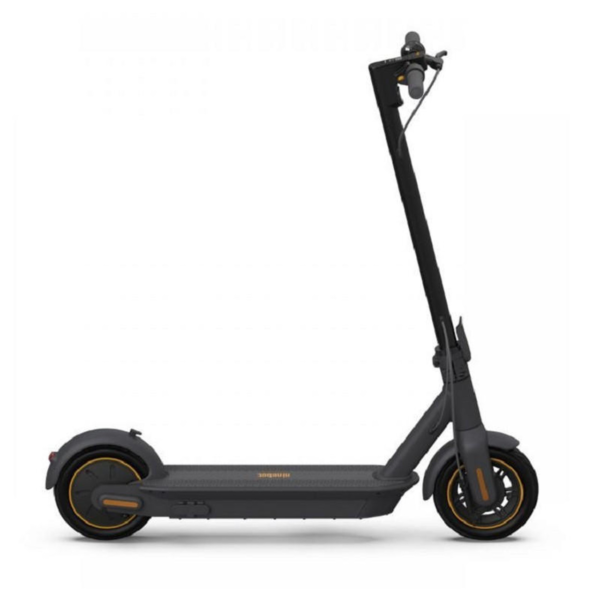
- Battery Range: 65 km (40.4 mi)
- Top Speed: 25 km/h (15.5 mph)
- Motor Power: 350 W nominal
- Weight Capacity: 100 kg (220 lb) max rider
- Charging Time: 6 h charge time (built-in 3 A)
- Scooter Weight & Portability: 19.9 kg (43.9 lb) scooter weight
PROS
- Up to 65 km range
- Built-in fast charger
- 10-inch tubeless self-sealing tyres
- Front drum + rear electronic brake
- RWD stability and solid deck
- IPX5 body / IPX7 core components
CONS
- Heavier than many commuters
- No suspension
- Capped at 25 km/h in EU
- Large folded footprint for small cupboards
- Stiff feel on brick/cobble at speed
Overview: Why the Segway Ninebot MAX G30 Still Matters
The Segway Ninebot MAX G30 remains a commuter benchmark because it nails the fundamentals riders care about: dependable range, straightforward upkeep, and a stable, confidence-building ride. While newer scooters chase headline specs, the MAX G30 keeps delivering the stuff that actually improves daily life. It combines a 350 W-class rear motor with a large 551 Wh battery for up to 65 km of theoretical range and a regulated 25 km/h top speed in EU markets. Because it also includes an integrated fast charger, 10-inch tubeless pneumatic tyres, and a durable dual-brake system (front drum + rear electronic regen), the MAX G30 still feels like an effortless, low-maintenance companion for city transit.
Control is calm and direct. Rear-wheel drive improves traction off the line while the low deck steadies the chassis in traffic. The 10-inch self-sealing tyres soften city seams and resist punctures, so you spend more time riding and less time wrenching. At night, a bright 2.5 W headlight and certified reflectors raise your profile to drivers. Charging stays simple and quick: the integrated 3 A charger fills the 551 Wh pack in about six hours. Meanwhile, the scooter carries IPX5 for the body and IPX7 for the motor/battery core components, which supports real-world commuting in light rain (with sensible care). Finally, the MAX G30 folds neatly for train aisles and office nooks. It is not the lightest platform, yet its balance of range, stability, and low maintenance is why many riders still choose it for everyday city travel.
Who the MAX G30 Is For
If your week looks like bike lanes, tram crossings, and short stretches of rough asphalt, the MAX G30 fits perfectly. Commuters who value predictability over flash will appreciate its relaxed handling, reliable braking, and practical range. Students who shuttle between campus buildings will love the plug-and-go charging and puncture-resistant tyres. New riders benefit from the scooter’s composed throttle response and surefooted rear-wheel drive. Even seasoned owners who’ve tried faster models often keep a MAX G30 for days when they just want to ride, not fiddle.
Because many cities enforce strict top-speed rules, a scooter that rides beautifully at 25 km/h can be more useful than one that sprints beyond local limits. The MAX G30 accepts those rules and turns them into strengths: better battery endurance, calmer steering, and less mechanical stress. As a result, you get a scooter that feels balanced almost everywhere.
Design Philosophy: Built for Real-World Use
The MAX G30’s design looks simple at a glance, yet it hides smart decisions. The stem locks with reassuring solidity. The deck sits at a friendly height, so stepping on and off feels natural at a crowded light. Handlebars land at a relaxed reach, with controls that are easy to operate in gloves. The cable routing stays tidy. Nothing screams for constant adjustment. Because the frame geometry emphasizes composure, the scooter tracks straight over patches and seams that nudge lighter, twitchier models.
This calm character does not dull the ride. Instead, it invites you to ride more often. You don’t second-guess the scooter or fight it in gusts. You just point it where you want to go and let it do its job.
Motor and Drivetrain: Smooth, Predictable Power
A 350 W-class rear motor powers the MAX G30. On paper, the number looks modest compared to modern wattage wars. On the street, it feels just right. Power rolls in smoothly, without a lurch, so starts in traffic feel composed. Because the motor drives the rear wheel, weight transfer under acceleration improves traction on wet paint or dusty cobblestones. Moreover, the controller maps throttle input progressively, which helps beginners avoid over-correction and lets experienced riders meter speed precisely in crowds.
The top speed aligns with EU regulations at 25 km/h. That cap may sound limiting, yet it keeps the scooter in its efficiency sweet spot, preserves range, and reduces component stress. Consequently, the MAX G30 feels dependable long after newer, harder-stressed scooters need attention.
Battery and Range: Why 551 Wh Still Wins Commutes
Range anxiety ruins commutes. The MAX G30 solves it with a 551 Wh battery that consistently delivers meaningful distance. In careful hands and favorable conditions, you can approach 65 km per charge. In mixed conditions—hills, headwinds, frequent stops—you still typically finish multi-errand days without hunting for an outlet. Because the pack sits low and central, handling remains steady as the battery depletes. You don’t feel the scooter get nervous at the end of a ride.
Practical ways to stretch range:
- Accelerate progressively and hold steady speeds when possible.
- Keep tyres inflated to the recommended pressures.
- Use Eco or Standard mode when lanes are busy.
- Avoid long periods at full throttle into strong headwinds.
- Store and charge at room temperature for best battery health.
Implement these habits and your real-world range creeps closer to the scooter’s theoretical promise.
Charging Experience: Truly “Plug and Go”
The MAX G30 bakes convenience into your routine thanks to its integrated 3 A charger. You only carry a standard cable. No brick. No mess. Because the time from low to full lands around six hours, you can charge at your desk during a workday or top up at home overnight. Partial charges work fine, too. If you roll in at 50%, a short session pulls you back to a comfortable buffer. As a result, you build a low-effort rhythm: ride, plug, repeat.
Tyres and Ride Quality: 10-Inch Tubeless for the Win
Tyres define a scooter’s personality. The MAX G30 rides on 10-inch tubeless pneumatic tyres with self-sealing protection. Bigger tyres smooth cracked pavement and shrug off small potholes that rattle 8-inch wheels. The tubeless design reduces the odds of pinch flats and, with proper sealant, can self-heal minor punctures. Because the contact patch is generous, you get consistent grip during braking and cornering. Meanwhile, the carcass flex filters vibrations before they reach your hands and feet. That comfort compounds across a week, saving energy on longer rides.
Braking: Simple, Durable, and Effective
Braking hardware should inspire confidence without constant tuning. The MAX G30’s front drum brake excels at that. It resists grit, stays consistent in wet conditions, and requires fewer adjustments than exposed calipers. At the rear, electronic regenerative braking helps shed speed and recapture a bit of energy on descents. The two systems complement each other: the drum supplies physical bite; regen smooths and stabilizes the chassis. Because lever feel remains progressive, you can modulate easily in slick conditions.
Stopping tips for city riders:
- Look far ahead and brake early when surfaces look shiny.
- Keep the scooter upright during hard stops; finish turns before heavy braking.
- Squeeze the lever progressively rather than grabbing it suddenly.
These basics pair beautifully with the G30’s hardware.
Weather Readiness: Real IP Ratings, Real Caution
City weather rarely waits for your schedule. Fortunately, the MAX G30 holds IPX5 on the body and IPX7 for key core components like the motor and battery. In practice, that means light rain riding is viable when you take sensible care. You still avoid deep puddles, aggressive washing, and long slogs in heavy downpours. However, you no longer cancel a commute because a shower rolled in. Dry the scooter afterward, store it indoors, and occasionally inspect seals and ports. Because the scooter was designed with these conditions in mind, it stays in service rather than in the closet.
Stability and Handling: Calm in Crowds, Centered at Speed
The MAX G30’s geometry favors stability. The wheelbase and steering angle work together to keep the scooter centered, even on uneven surfaces. The deck’s height lowers your center of gravity, which helps in quick lane changes and emergency stops. Because the bars are wide enough for leverage without being awkward in tight gaps, you can steer decisively. The result is a chassis that behaves predictably at commuting speeds and remains calm when wind or road texture changes unexpectedly.
Display, Controls, and Modes: Information Without Clutter
The cockpit stays refreshingly simple. The central display shows speed, battery bars, and mode at a glance. The buttons do what you expect, and the throttle has a smooth throw. You get several ride modes—Eco, Standard, and Sport—so you match behavior to context. Eco extends range and softens throttle response, which helps in crowded lanes. Standard fits most rides with balanced performance. Sport sharpens acceleration for hills or headwinds. Because you can switch on the move, you adapt instantly as conditions evolve.
Daily Practicality: Fold, Roll, Stow
The MAX G30 folds quickly for train platforms, office hallways, and apartment elevators. The latch feels sturdy, and the folded package stays manageable. The scooter’s weight sits in the mid-to-heavy commuter range, so frequent stair carries can feel taxing. Even so, its folded shape slides into car trunks and under desks with minimal fuss. If you can store it at ground level or near an elevator, the weight becomes a non-issue, and you reap the benefits of its robust build every day.
Maintenance: Low Effort, High Payoff
Simplicity keeps the MAX G30 in service. Drum brakes need little attention compared to exposed discs. Tubeless tyres resist common commuter flats. The integrated charger removes the “where’s my brick?” headache. You still perform basic checks, of course, yet those checks go quickly.
Quick upkeep routine:
- Weekly: Verify tyre pressure; wipe the lights and reflectors; inspect the folding joint.
- Monthly: Check drum brake cable tension; examine tyre tread and sidewalls; review fasteners.
- Quarterly: Refresh sealant; clean connectors; inspect charging port and rubber gaskets.
- Annually: Replace tyres and brake components as needed; run a battery health check.
Follow this cadence and the scooter stays quiet, tight, and efficient.
Safety and Visibility: Be Seen, Be Understood
A 2.5 W headlight pushes a clean beam down the road. Certified reflectors add passive visibility from multiple angles, which helps at intersections. Because the scooter’s stance is solid, you don’t wobble when you signal or adjust speed. In practice, this composure lowers conflict with cars and cyclists. You show up. You hold your line. You communicate clearly with light, position, and speed.
Hill Performance: Honest, Manageable Climbing
Urban climbs vary. The MAX G30 doesn’t bulldoze steep grades like higher-wattage performance scooters. Nevertheless, it holds steady on typical city hills, especially in Sport mode. Because power delivery remains predictable, you maintain a clean line. You may lose a few km/h on the steepest ramps, yet the scooter seldom feels overwhelmed. Keep your weight centered, look ahead, and let the motor pull you through.
Why It Outlasts Trendy Alternatives
Scooter trends move fast: bigger motors, exotic suspension, towering displays. Many look impressive for a month and then spend time in repair queues. The MAX G30 has earned a different reputation. It focuses on durability, range, and sane ergonomics. It chooses drum braking for resilience. It opts for tubeless tyres for puncture resistance. It packages a charger inside the scooter to remove everyday friction. None of those choices chase internet headlines. All of them shorten the distance between you and your next ride.
Because the fundamentals age well, the MAX G30 holds value in the real world. Riders keep them longer, sell them more easily, and recommend them more confidently. That word-of-mouth momentum is the strongest proof that the formula still works.
App and Connectivity: Useful, Not Distracting
Modern scooters often bury riders in app toggles. The MAX G30 keeps things practical. You pair quickly, view basics like mileage and battery percentage, and apply updates when needed. You can tweak settings without falling down a settings rabbit hole. Because the scooter rides well out of the box, you spend more time on the deck and less time on your phone.
Common Commuter Scenarios
Morning Dash to the Train:
You roll out with the headlight on. The scooter warms into Standard mode for a stable 22–25 km/h cruise. A patch of slick cobbles appears; rear-wheel drive keeps launch traction, and you stay straight. You fold at the platform, board, and unfold at the other end without fuss.
Lunch Errands Across Town:
Crowded lanes favor Eco mode. Throttle input softens, which makes 15–20 km/h weaving smooth and polite. Drum braking manages micro-stops cleanly outside shops. You knock out two errands and return with plenty of battery.
Evening Return in Light Rain:
IP protections and sensible speeds make the ride straightforward. You slow earlier for intersections, keep braking upright, and finish the day at home with charge to spare. Ten minutes later, the scooter sits connected to the wall cable, drying indoors.
Maximizing Comfort on Long Rides
Little adjustments add up to big comfort:
- Stance: Place your front foot angled on the deck and your rear foot slightly offset. This stance stabilizes the hips and reduces fatigue.
- Grip: Keep elbows soft; don’t death-grip the bars over rough patches.
- Pressure: Tune tyre pressure for your weight and surface. Slightly lower pressures increase comfort but watch for rim strikes on harsh edges.
- Pacing: Ride at a steady rhythm. Constant sprints waste energy (yours and the battery’s).
Because the MAX G30 already smooths much of the road, these habits turn “fine” comfort into “great” comfort.
Cost of Ownership: Predictable and Reasonable
Ownership costs depend on wear items and downtime. The MAX G30 keeps both under control. Drum brakes wear slowly and need infrequent service. Tubeless tyres last well and shrug off small punctures. The battery’s capacity reduces deep-cycle stress during daily commuting, which supports long-term health. Because the scooter is popular, parts and service information stay easy to find. Consequently, you spend money and time riding rather than troubleshooting.
Comparisons: Old Favorite vs. New Hotness
- Against Lightweight City Scooters: The MAX G30 weighs more, yet it rides calmer, stops more confidently, and goes farther per charge. If you climb stairs daily, a featherweight wins on convenience. If you ride longer distances, the MAX G30 wins on sanity.
- Against High-Power Models: Big motors feel thrilling, but they drain batteries faster and often need more attention. At legal urban speeds, the MAX G30 feels planted and efficient, which frequently matters more.
- Against Budget Picks: Cheaper scooters exist. However, they often cut corners on tyres, battery capacity, or weather sealing. Those cuts show up as flats, short range, and early failures. The MAX G30 avoids those traps.
Because the MAX G30’s strengths align with daily needs, it keeps winning the practical comparison.
FAQs: Quick Answers for Busy Riders
Is 25 km/h fast enough?
Yes. In mixed city traffic, 25 km/h matches the pace of seasoned cyclists and allows safe stopping distances. Efficiency also improves at this speed.
How far will I get on one charge—really?
Up to 65 km is possible with smooth riding on flat ground. Most commuters see less in winter or on hilly routes. Good habits reclaim surprising range.
Can I ride in the rain?
Light rain with caution, yes. The scooter’s IP ratings help. Avoid deep water and clean the scooter afterward.
What about hills?
The motor handles typical urban grades, especially in Sport mode. Expect slower speeds on steep or extended climbs.
How often should I service it?
Follow the quick upkeep routine: weekly checks, monthly cable/tread inspection, quarterly sealant refresh, and annual wear-item replacements as needed.
A Simple Maintenance Checklist
- Before Each Ride: Quick visual look at tyres, lights, and folding latch.
- Weekly: Pressure check and wipe-down of reflectors/headlight; quick bolt check.
- Monthly: Brake cable assessment and deck grip inspection; charging port gasket review.
- Quarterly: Tyre sealant top-up; connector cleaning; full fastener torque sweep.
- Annually: Tyre replacement if worn; brake hardware refresh; battery health evaluation.
This cadence keeps performance crisp and avoids surprise downtime.
Final Verdict: Dependability Is a Feature
The Segway Ninebot MAX G30 still matters because it understands the real job of a commuter scooter. It carries a 551 Wh battery that actually stretches across workdays. It uses 10-inch tubeless tyres that protect your schedule from punctures. It brakes with a front drum and rear electronic system that stay consistent when the streets turn slick. It includes a 3 A charger inside the scooter so you charge anywhere with a simple cable. It holds IPX5/IPX7 protections that support all-weather practicality when you ride with care. And it sticks to a 25 km/h top speed that keeps control, efficiency, and legal compliance intact.
You can chase flashier numbers. Or you can pick the scooter that gets you there, day after day, with minimal drama. The MAX G30 chooses the second path. Consequently, many riders still choose it back.
Specifications
General
| Model The Model specifies the exact version or name of the scooter. It helps identify its unique design, features, and specifications within the manufacturer’s product line. Knowing the model makes it easier to compare options, find compatible accessories, or look up support information. | Ninebot MAX G30 |
| Brand The Brand identifies the manufacturer or company that designs and produces the scooter. A trusted brand is a sign of quality, reliability, and good customer support. Well-known brands often have higher standards for safety, performance, and after-sales service, giving you more confidence in your purchase. | Segway |
| Release Date The Release Date indicates when the scooter model was officially launched on the market. This helps you know how current the design, technology, and features are. A newer release date often means updated components, improved performance, and the latest safety or smart features. | 17 November 2025 |
| Recommended Age Recommended Age indicates the minimum age range that the scooter is designed for, based on safety, size, and ease of use. Following the recommended age helps ensure that riders can handle the scooter’s speed, weight, and controls comfortably and safely. Always check local laws and use protective gear, especially for younger riders. | Recommended 16+ |
Performance & Power
| Motor Power (Wattage) What it means: The motor power, measured in watts (W), shows how strong the scooter’s electric motor is. Why it matters: Higher wattage usually means better acceleration, more torque, and improved performance on hills or rough terrain. For example, a 250W motor is good for flat city roads and light riders, while a 500W or 1000W motor provides more power for faster speeds or climbing steep inclines. | 350 W nominal (rear motor) |
| Top Speed The Top Speed indicates the maximum speed that the scooter can reach under optimal conditions. It’s usually measured on level ground with a fully charged battery and an average rider weight. A higher top speed allows you to travel longer distances faster, but always ensure you ride within legal speed limits and your personal comfort zone for safety. | 25 km/h (15.5 mph) |
| Battery Capacity Battery Capacity refers to the total amount of energy the scooter’s battery can store, usually measured in ampere-hours (Ah) or watt-hours (Wh). A higher battery capacity means you can ride longer distances on a single charge, reducing the need for frequent recharging. Keep in mind that actual range can vary depending on rider weight, terrain, speed, and weather conditions. | 551 Wh (36 V, 15.3 Ah) |
| Estimated Range per Charge The Estimated Range per Charge indicates the average distance the scooter can travel on a single full battery charge. This range is calculated under optimal conditions, such as flat terrain, moderate speed, and average rider weight. Real-world range may vary depending on riding style, terrain, weather, and load. A longer range means fewer recharges and greater freedom for longer trips. | Up to 65 km (40.4 mi) |
| Hill Climb Ability Hill Climb Ability describes the maximum incline or slope that the scooter can handle while maintaining stable performance. It’s typically expressed as a percentage or in degrees. A higher hill climb rating means the scooter can tackle steeper hills without losing too much speed or power. Actual climbing performance may vary based on rider weight, battery charge, and terrain conditions. | Up to 20% grades |
| Drive System The Drive System refers to how power from the motor is delivered to the wheels. Electric scooters typically use either a hub motor (directly integrated into the wheel) or a chain/belt drive system. A high-quality drive system ensures smooth acceleration, efficient power transfer, and low maintenance. The choice of drive system affects performance, noise level, and overall ride experience. | Rear hub motor (RWD) |
Charging & Electrical
| Charging Time Charging Time indicates how long it takes to fully recharge the scooter’s battery from empty to 100% using the standard charger provided. Faster charging means less downtime and more time on the road. Actual charging time may vary slightly depending on battery capacity, charger output, and environmental conditions. | Approx. 6 hours (3 A built-in) |
| Battery Type Battery Type refers to the specific technology used in the scooter’s battery, which affects performance, lifespan, weight, and charging time. Most modern electric scooters use high-quality lithium-ion (Li-ion) batteries because they offer a good balance of energy density, durability, and low maintenance. A reliable battery type ensures consistent power delivery and longer riding ranges. | Li-ion with Smart BMS |
| Removable Battery A Removable Battery means the battery pack can be easily detached from the scooter for convenient charging and replacement. This feature allows you to charge the battery separately, swap it with a spare for extended range, or securely store it indoors in extreme weather. Removable batteries add flexibility and make it easier to keep your scooter powered up wherever you are. | 5 A external fast charger optional |
| Regenerative Braking Regenerative Braking is an energy-saving feature that converts some of the energy normally lost during braking back into battery power. When you slow down or brake, the motor works in reverse to generate electricity, which helps extend the scooter’s range and improves overall efficiency. This system also reduces wear on traditional brake components, leading to lower maintenance over time. | Regenerative electronic brake |
| Lighting Lighting refers to the built-in front and rear lights that enhance visibility and safety when riding in low-light conditions or at night. Good lighting helps you see the road ahead and ensures that other road users can see you. Many scooters include LED headlights, taillights, and sometimes brake lights or side reflectors for added safety and compliance with local traffic regulations. | 2.5 W front LED + rear/brake LED |
Build & Dimensions
| Scooter Weight Scooter Weight refers to the total weight of the scooter when fully assembled, including the battery. This affects how easy it is to carry, lift, and store the scooter when not in use. A lighter scooter is more portable and convenient for commuting, especially if you need to carry it upstairs or onto public transport. Keep in mind that a sturdy frame and quality components may add to the weight but also contribute to better durability and ride stability. | 19.9 kg (43.9 lb) |
| Maximum Rider Weight Maximum Rider Weight indicates the highest rider weight that the scooter is designed to safely support while maintaining optimal performance and stability. Staying within this limit helps ensure reliable acceleration, braking, and climbing ability, and it protects the frame, suspension, and motor from excessive strain. Exceeding the recommended limit may reduce performance and increase wear on components. | 100 kg (220 lb) |
| Deck Size Deck Size refers to the dimensions of the scooter’s standing platform. A wider and longer deck provides more foot space, allowing you to stand comfortably and adjust your stance while riding. A well-sized deck improves balance and stability, especially on longer rides or at higher speeds. Compact decks, on the other hand, help keep the scooter lightweight and portable. | Low-profile deck (stable) |
| Handlebar Height Handlebar Height refers to the distance from the deck to the handlebars, which affects your riding posture and comfort. An appropriate handlebar height helps you maintain good balance, reduces strain on your back and arms, and makes steering more comfortable. Some scooters have adjustable handlebars to fit riders of different heights, while others have a fixed height for a streamlined design. | Adult-friendly fixed height |
| Folding Mechanism The Folding Mechanism describes how easily and securely the scooter can be folded for carrying and storage. A well-designed folding system lets you quickly collapse the scooter into a compact size, making it convenient to transport on public transit, store under a desk, or fit into a car trunk. Look for sturdy latches and safety locks to ensure the scooter stays firmly in place when folded or unfolded. | Quick folding latch |
| Dimensions Folded Dimensions indicate the size of the scooter when it’s fully folded. This measurement shows how much space the scooter will take up when stored or carried, making it easier to check if it will fit in your car trunk, under a desk, or in a closet. Compact folded dimensions are ideal for commuters who need to bring their scooter on public transport or store it in tight spaces. | 1167 × 472 × 534 mm (folded) |
| Material Material refers to the primary construction materials used for the scooter’s frame and key components. High-quality materials like aircraft-grade aluminum, reinforced steel, or durable composites provide strength, stability, and a lighter overall weight. A sturdy material ensures the scooter can handle daily wear and tear while maintaining safety and performance. | Aluminum alloy |
Safety & Control
| Brake Type(s) Brake Type(s) describe the braking systems the scooter uses to help you slow down or stop safely. Common brake types include mechanical brakes (like drum or disc brakes), electronic brakes, and foot brakes. Many scooters combine multiple braking systems for added safety and shorter stopping distances. The type and quality of brakes affect your control, especially when riding at higher speeds or on slopes. | Front drum + rear electronic |
| Suspension Suspension refers to the system that absorbs shocks and vibrations while riding, providing a smoother and more comfortable ride over uneven or rough surfaces. Scooters may have front suspension, rear suspension, or dual suspension for better shock absorption and stability. Good suspension helps reduce rider fatigue and improves control, especially when riding on bumpy roads or off-road paths. | None |
| Tire Type Tire Type refers to the kind of tires the scooter uses, which directly affects ride comfort, traction, and maintenance. Common types include solid (airless) tires, pneumatic (air-filled) tires, or hybrid options. Pneumatic tires offer better shock absorption and a smoother ride on rough surfaces, while solid tires are puncture-proof and require less upkeep. The right tire type helps ensure safe handling and a comfortable ride in different conditions. | Tubeless pneumatic, self-sealing |
| Tire Size Tire Size indicates the diameter and width of the scooter’s tires, which affect ride comfort, stability, and how well the scooter handles different terrains. Larger tires generally offer better shock absorption and a smoother ride over bumps and rough surfaces, while smaller tires keep the scooter lighter and more portable. Choosing the right tire size helps ensure a balance between agility and comfort. | 10-inch |
| Kickstand The Kickstand is a built-in stand that allows you to park your scooter upright when it’s not in use. A sturdy kickstand keeps the scooter stable and prevents it from tipping over, protecting it from scratches and damage. It also makes storing and accessing your scooter more convenient, whether you’re at home, work, or on the go. | Side kickstand |
| Water Resistance Rating Water Resistance Rating indicates how well the scooter is protected against water and moisture, usually shown as an IP (Ingress Protection) rating. This rating helps you understand whether the scooter can handle light rain, splashes, or wet roads without damage. While most scooters are not fully waterproof, a good water resistance rating adds peace of mind when riding in changing weather conditions. Always avoid deep puddles or submerging the scooter to protect its electrical components. | IPX5 body / motor IPX7 |
Features & Extras
| Display/Console The Display (or Console) shows important real-time information about your ride, helping you monitor your scooter’s status at a glance. Typical displays show speed, battery level, distance traveled, and riding mode. Some models also include additional features like Bluetooth connectivity, app integration, or backlighting for better visibility at night. A clear and easy-to-read display enhances safety and convenience on every trip. | LED dashboard |
| Ride Modes Ride Modes refer to the different speed and power settings you can choose to match your riding style or road conditions. Common modes include eco for maximum range and energy efficiency, standard for everyday balance, and sport or turbo for higher speed and stronger acceleration. Switching between ride modes allows you to customize performance, conserve battery, and ride safely in various environments. | Eco, Drive, Sport + Pedestrian |
| Smart App Connectivity Smart App Connectivity lets you pair your scooter with a dedicated mobile app via Bluetooth. Using the app, you can monitor real-time ride stats like speed, battery level, and range, adjust settings such as ride modes or cruise control, lock the scooter for added security, and sometimes receive firmware updates. This feature adds convenience and allows you to personalize your riding experience right from your smartphone. | Bluetooth app (Segway-Ninebot) |
| Anti-Theft System The Anti-Theft System helps protect your scooter from unauthorized use or theft. This feature can include built-in alarms, electronic motor locks, GPS tracking, or remote locking through a mobile app. A good anti-theft system provides peace of mind when parking your scooter in public spaces, adding an extra layer of security to safeguard your investment. | Built-in charger, rear-wheel drive |
| Cruise Control Cruise Control allows you to maintain a steady speed without continuously holding the throttle. This feature makes longer rides more comfortable by reducing hand fatigue and providing a smoother, more relaxed riding experience — especially on flat, open roads or bike lanes. For safety, cruise control can usually be easily activated or deactivated while riding. | Yes |
| Accessories Included Accessories Included lists the additional items that come with the scooter to enhance your riding experience and convenience. Common accessories may include a charger, kickstand, bell, lights, phone holder, or carrying strap. These extras add value by making your scooter safer, easier to use, and ready to ride straight out of the box. | Bell, E-MARK reflectors, charger |
Warranty & Compliance
| Warranty Period The Warranty Period indicates how long the manufacturer guarantees the scooter against defects in materials and workmanship under normal use. A good warranty provides peace of mind, showing the brand’s confidence in its product quality. Always check what parts are covered, such as the frame, battery, and motor, and follow the maintenance guidelines to keep your warranty valid. | Typically 12 months (regional) |
| Certifications Certifications confirm that the scooter meets specific safety, quality, and environmental standards set by recognized organizations or regulatory bodies. Common certifications may include CE, RoHS, UL, or other local compliance marks, depending on your region. These certifications ensure that the scooter is manufactured to high standards and is safe and legal to use in your country. | CE; E-MARK reflectors; local compliance |




